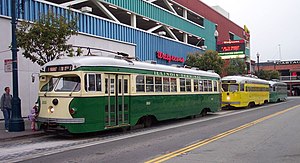PCC 7900
| PCC streetcar | |
|---|---|

Three PCCs on the San Francisco Municipal Railway's F-line. An example of one double-ended streetcar and two former SEPTA cars.
|
|

Interior of a PCC car
|
|
| In service | 1936–present |
| Manufacturer |
St. Louis Car Company Pullman-Standard |
| Constructed | 1936–1952 |
| Scrapped | 1950s–1998 |
| Number built | 5000 |
| Capacity | 52–61 Seats |
| Specifications | |
| Car length | 46–50.5 ft (14.02–15.39 m) |
| Width | 100–108 in (2.54–2.74 m) |
| Maximum speed | 50 mph (80 km/h) |
| Weight | 35,000–42,000 lb (15,900–19,100 kg) |
| Traction system | 4 x 55 hp (41 kW) motors, 43:6 (~7.17) gear ratio |
| Acceleration | Variable, Automatic 1.5–4.75 mph/s (2.41–7.64 km/(h·s)) |
| Deceleration |
Service: Variable to 4.75 mph/s (7.64 km/(h·s)), Emergency: 9.0 mph/s (14.5 km/(h·s)) maximum |
| Electric system(s) | 600 V or 750 V DC Overhead lines |
| Current collection method | Pantograph or Trolley pole |
| Braking system(s) | Dynamic Service Braking; Friction; for Final Stop, Park; Magnetic |
| Track gauge | Wide, Standard, Narrow Gauges |
The PCC (Presidents’ Conference Committee) is a streetcar (tram) design that was first built in the United States in the 1930s. The design proved successful in its native country, and after World War II it was licensed for use elsewhere in the world. The PCC car has proved to be a long-lasting icon of streetcar design, and PCC cars are still in service around the world.
The "PCC" in this car's name comes from the name of a design committee formed in 1929 as the "Presidents' Conference Committee" and renamed the "Electric Railway Presidents' Conference Committee" (ERPCC) in 1931. This group's membership consisted mostly of representatives of some of the larger operators of urban electric street railways in the United States plus potential manufacturers. Three interurban lines and at least one "heavy rail," or rapid transit, operator - the Chicago Rapid Transit Company - were represented as well. Also included on the membership roll were manufacturers of surface cars (streetcars) and interested component suppliers. The ERPCC goal was to design a streamlined, comfortable, quiet, and fast accelerating and braking streetcar that would be operated by a seated operator utilizing floor mounted pedal controls to better meet the needs of the street railways and to better appeal to riders. The committee prepared a detailed research plan, conducted extensive research on streetcar design, built and tested components, made necessary modifications and revisions based upon the findings, and, in the end, produced a set of specifications for a standardized and fixed design (albeit one with a modest list of available options with some room for customer customization) to be built with standard parts as opposed to a custom designed carbody with any variety of different parts added depending on the whims and requirements of the individual customer. An excellent product emerged, the PCC car, as was proved in later years by numerous national and international users.
Many design patents resulted from the work of the ERPCC. These were transferred to a new business entity called the Transit Research Corporation (TRC) at the time of the committee's expiration in 1936. Although this company would continue the work of research on improvements to the basic design of the car and would issue sets of specifications three times in the ensuing years, because TRC defined a PCC car as any vehicle which utilized patents on which it collected royalties, it was formed for the primary purpose of controlling those patents and promoting the standardization envisioned by the ERPCC. The company was funded by its collection of patent royalties from the railways which bought PCC cars. The company was controlled by a voting trust representing the properties which had invested in the work of the ERPCC. One participant in Committee meetings, Philadelphia trolley manufacturer J. G. Brill and Company brought a competitive design—the Brilliner—to market in 1938. With Raymond Loewy designed elements and very similar to the PCC look, the Brilliner attracted no large orders, being built only for Atlantic City Transit and the Red Arrow Lines in suburban Philadelphia. Fewer than 50 were sold.
...
Wikipedia
